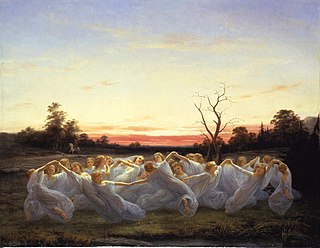
An elf is a type of humanoid supernatural being in Germanic folklore. Elves appear especially in North Germanic mythology, being mentioned in the Icelandic Poetic Edda and Snorri Sturluson's Prose Edda.
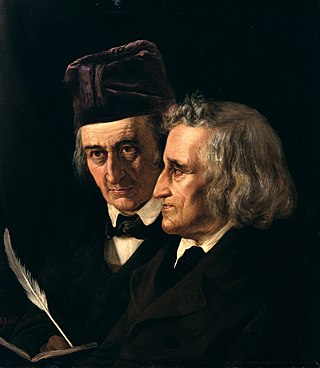
The Brothers Grimm, Jacob (1785–1863) and Wilhelm (1786–1859), were German academics who together collected and published folklore. The brothers are among the best-known storytellers of folktales, popularizing stories such as "Cinderella", "The Frog Prince", "Hansel and Gretel", "Town Musicians of Bremen", "Little Red Riding Hood", "Rapunzel", "Rumpelstiltskin", "Sleeping Beauty", and "Snow White". Their first collection of folktales, Children's and Household Tales, began publication in 1812.

A dwarf is a type of supernatural being in Germanic folklore. Accounts of dwarfs vary significantly throughout history; however, they are commonly, but not exclusively, presented as living in mountains or stones and being skilled craftspeople. In early literary sources, only males are explicitly referred to as dwarfs. However, they are described as having sisters and daughters, while male and female dwarfs feature in later saga literature and folklore. Dwarfs are sometimes described as short; however, scholars have noted that this is neither explicit nor relevant to their roles in the earliest sources.

A kobold is a mythical sprite. Having spread into Europe with various spellings including "goblin" and "hobgoblin", and later taking root and stemming from Germanic mythology, the concept survived into modern times in German folklore.

In Breton folklore, a Korrigan is a fairy or dwarf-like spirit. The word korrigan means in Breton "small-dwarf". It is closely related to the Cornish word korrik which means gnome. The name changes according to the place. Among the other names, there are korrig, korred, korrs, kores, couril, crion, goric, kornandon, ozigan, nozigan, teuz, torrigan, viltañs, poulpikan, poulpiquet, and paotred ar sabad.
Thomas Keightley was an Irish writer known for his works on mythology and folklore, particularly Fairy Mythology (1828), later reprinted as The World Guide to Gnomes, Fairies, Elves, and Other Little People.

Hinzelmann or Heinzelmann was a kobold in the mythology of northern Germany. He was described as a household spirit of ambivalent nature, similar to Puck. Like Puck, he would provide good luck and perform household tasks, but would become malicious if not appeased.

Swiss folklore describes a collection of local stories, celebrations, and customs of the alpine and sub-alpine peoples that occupy Switzerland. The country of Switzerland is made up of several distinct cultures including German, French, Italian, as well as the Romansh speaking population of Graubünden. Each group has its own unique folkloric tradition.

German folklore is the folk tradition which has developed in Germany over a number of centuries. Seeing as Germany was divided into numerous polities for most of its history, this term might both refer to the folklore of Germany proper and of all German-speaking countries, this wider definition including folklore of Austria and Liechtenstein as well as the German-speaking parts of Switzerland, Luxembourg, Belgium, and Italy.
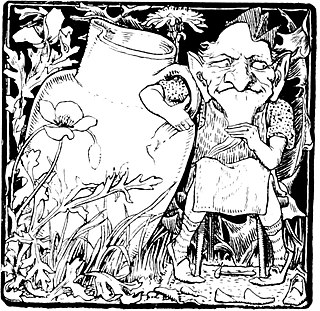
The clurichaun or clúrachán is a mischievous fairy in Irish folklore known for his great love of drinking and a tendency to haunt breweries, pubs and wine cellars. He is related to the leprechaun and has sometimes been conflated with him as a shoemaker and a guardian of hidden treasure. This has led some folklorists to suppose that the clurichaun is merely a leprechaun on a drinking spree, while others regard them as regional variations of the same being. Like the leprechaun, the clurichaun is a solitary fairy, encountered alone rather than in groups, as distinct from the trooping fairies.
In Scottish and Northern English folklore, a shellycoat is a type of bogeyman that haunts rivers and streams.
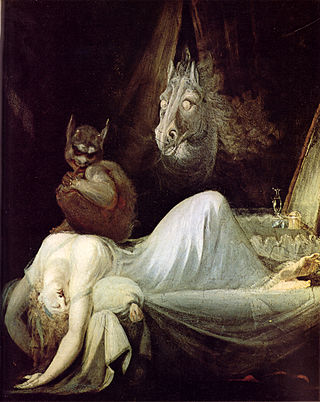
An Alp is a supernatural being in German folklore.
In Swiss folklore, Jack o' the bowl is a helpful house spirit and variously described as a brownie or kobold.

Elegast is the hero and noble robber in the poem Karel ende Elegast, an early Middle Dutch epic poem that has been translated into English as Charlemagne and Elbegast. In the poem, he possibly represents the King of the Elves. He appears as a knight on a black horse, an outcast vassal of Charlemagne living in the forest. The original Dutch poem uses the name Elegast, while translated versions of the poem commonly use the name Elbegast in German and English, or Alegast in the Scandinavian ballad.
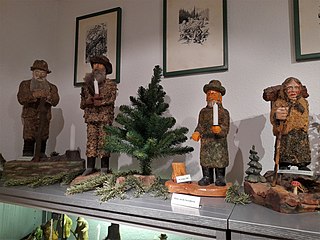
The moss people or moss folk, also referred to as the wood people or wood folk or forest folk, are a class of fairy folk, variously compared to dwarfs, elves, or spirits, described in German folklore as having an intimate connection to trees and the forest. In German, the words Schrat and Waldschrat are also used for a moss person. The diminutive Schrätlein also serves as synonym for a nightmare creature.
Hödekin is a kobold of German folklore. According to the legend recorded by folklorist Thomas Keightley in 1850, Hödekin always wore a felt hat down over his face; his name means "Little Hat". Hödekin lived with the Bishop of Hildesheim and was a helpful sprite.
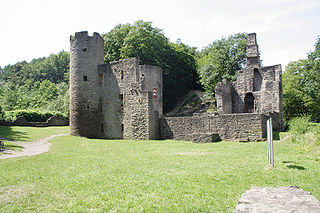
Hardenstein Castle is a ruined castle in North Rhine-Westphalia, Germany. The remains lie east of Herbede on the Ruhr River, surrounded by mountains, and are not easily accessible. Nearby ruins show that the castle was once part of an important mining centre, probably dating to the Middle Ages; the earliest records, from the 16th century, support this. The castle features in the legend of the Nibelungs.
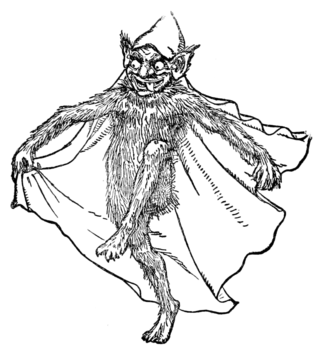
A goblin is a small, grotesque, monstrous creature that appears in the folklore of multiple European cultures. First attested in stories from the Middle Ages, they are ascribed conflicting abilities, temperaments, and appearances depending on the story and country of origin, ranging from mischievous household spirits to malicious, bestial thieves. They often have magical abilities similar to a fairy or demon, such as the ability to shapeshift.

Deutsche Sagen is a publication by the Brothers Grimm, appearing in two volumes in 1816 and 1818. The collection includes 579 short summaries of German folk tales and legends.
"The Soul Cages" is a fairy tale invented by Thomas Keightley, originally presented as a genuine Irish folktale in T. Crofton Croker's Fairy Legends and Traditions of the South of Ireland (1825–28). It features a male merrow (merman) inviting a local fisherman to his undersea home. The "soul cages" in the title refer to a collection of human souls that the merman kept in his home.















